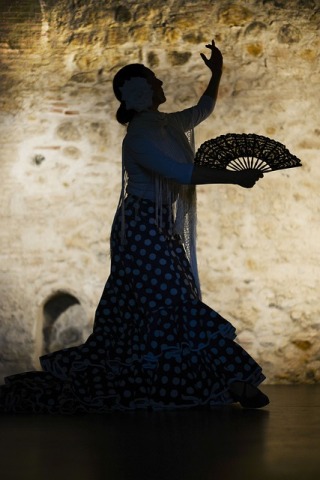1. I dance flamenco / Bailo flamenco
|
Hello Ulrike! My name is María and I am from Spain. I live in London and I am very happy with my dance grant. I am learning a lot and I am very glad I accepted the grant to come here. I think that ,the best way for you to get an idea of how things work here, is to explain to you what I do every day. I usually get up at seven o´clock in the morning. I always have a shower and get dressed. Then I have a tea and a toast for breakfast and I leave my flat. I sometimes take the underground to go to my dance academy, but on Mondays and Thursdays I take the bus at half past seven. I attend my dance lessons and I always have lunch at twelve o´clock. In the afternoon I take English, Geography and Maths lessons. I always take the underground back home but I never arrive home before six in the evening. Anne (my flatmate) always arrives before and she often prepares dinner for us both. She doesn´t eat meat because she is a vegetarian, so we never eat meat for dinner, she cooks pasta wonderfully. I don´t watch tv in the evening because I don´t understand it very well, but I usually listen to music or read in my bed. I hope you accept the grant and you come here. What do you do everyday? Do you cook? What kind of music do you dance? I am looking forward to your reply, best wishes, María
|
Imagen en Pixabay de prunkova de Dominio Público.
|
- Para decir lo que hacemos habitualmente María ha utilizado la persona que lo hace seguida de la acción:
I live-----yo me levanto
- Fíjate en que cuando la persona que hace la acción es él o ella (he/she) se le añade una -s a la acción:
I arrive ------ she arrives, yo llego------ella llegaSi la acción termina en -o, -sh,-ch,-ss se agrega -es en vez de una -s sólo:I go---she goesSi la acción termina en consonante+y, la -y pasa a ser -i y se añade -es.:I study---she studies
- María también le cuenta a Ulrike lo que no hace. Para negar se utiliza la persona + don´t + acción:
We don´t eat--- nosotros no comemos.Si la persona es él o ella (he/she) en vez de don´t ponemos doesn´t:She doesn´t eat----ella no come.
- María también le ha preguntado a Ulrike algunas cosas sobre sus actividades habituales. Para ello ha puesto do+persona que hace la acción+acción:
Do you cook?---¿Cocinas tú?
Si preguntásemos sobre él o ella se diría con does en vez de do:
Does she cook?---¿cocina ella?
Actividad
| Affirmative | Negative |
Interrogative |
| I eat: yo como |
I don´t eat: yo no como |
Do I eat?: ¿como yo? |
| You eat: tu comes | You don´t eat: tu no comes |
Do you eat?: ¿Comes tú? |
| He eats: él come |
He doesn´t eat: él no come |
Does he eat?: ¿Come él? |
| She eats: ella come | She doesn´t eat: ella no come |
Does she eat?: ¿come ella? |
| It eats: eso come |
It doesn´t eat:eso no come |
Does it eat?: ¿Come eso? |
| We eat: nosotros comemos | We don´t eat: nosotros no comemos | Do we eat?: ¿Comemos nosotros? |
| You eat: vosotros coméis |
You don´t eat: vosotros no coméis |
Do you eat?: ¿Coméis vosotros? |
| They eat: ellos comen |
They don´t eat : ellos no comen |
Do they eat?: ¿Comen ellos? |
|
Short answers Repuestas cortas |
Affirmative Yes, I do Yes, she does |
Negative No, I don´t No, she doesn´t |
p>Aquí tienes unos vídeos con explicaciones de este tiempo verbal para que lo puedas repasar:
Pre-conocimiento
AV - Actividad de Espacios en Blanco
Rellena los huecos con la forma de simple present del verbo entre paréntesis.
Actividad de Lectura
Escribe estas frases en negativo e interrogativo:
1.- I live in Madrid.
2.- She goes to school.
3.- We eat pasta.
4.- Anne reads the book.
